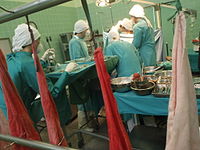
Photo from wikipedia
BACKGROUND AIMS Adipose tissue-derived mesenchymal stromal cells (AT-MSCs), widely known as multipotent progenitors, release several cytokines that support cell survival and repair. There are in vitro and in vivo studies… Click to show full abstract
BACKGROUND AIMS Adipose tissue-derived mesenchymal stromal cells (AT-MSCs), widely known as multipotent progenitors, release several cytokines that support cell survival and repair. There are in vitro and in vivo studies reporting the regenerative role of AT-MSCs possibly mediated by their protective effects on functional islet cells as well as their capacity to differentiate into insulin-producing cells (IPCs). METHODS On such a basis, our goal in the present study was to use three different models including direct and indirect co-cultures and islet-derived conditioned medium (CM) to differentiate AT-MSCs into IPCs and to illuminate the molecular mechanisms of the beneficial impact of AT-MSCs on pancreatic islet functionality. Furthermore, we combined in vitro co-culture of islets and AT-MSCs with in vivo assessment of islet graft function to assess whether co-transplantation of islets with AT-MSCs can reduce marginal mass required for successful islet transplantation and prolong graft function in a diabetic rat model. RESULTS Our findings demonstrated that AT-MSCs are suitable for creating a microenvironment favorable for the repair and longevity of the pancreas β cells through the improvement of islet survival and maintenance of cell morphology and insulin secretion due to their potent properties in differentiation. Most importantly, hybrid transplantation of islets with AT-MSCs significantly promoted survival, engraftment and insulin-producing function of the graft and reduced the islet mass required for reversal of diabetes. CONCLUSIONS This strategy might be of therapeutic potential solving the problem of donor islet material loss that currently limits the application of allogeneic islet transplantation as a more widespread therapy for type 1 diabetes.
Journal Title: Cytotherapy
Year Published: 2018
Link to full text (if available)
Share on Social Media: Sign Up to like & get
recommendations!